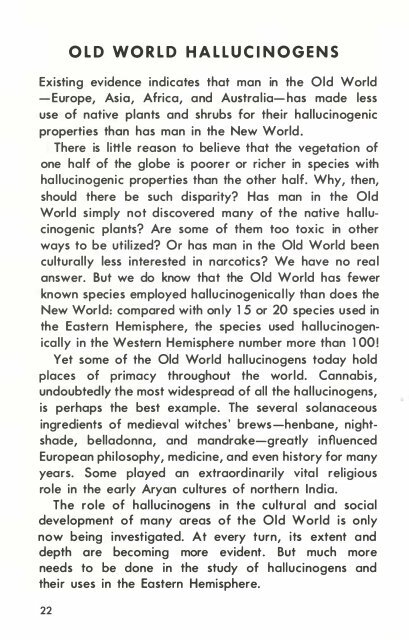3S9rydC3U
3S9rydC3U
3S9rydC3U
Create successful ePaper yourself
Turn your PDF publications into a flip-book with our unique Google optimized e-Paper software.
OLD WORLD HALLUCINOGENSExisting evidence indicates that man in the Old World-Europe, Asia, Africa, and Australia-has made lessuse of native plants and shrubs for their hallucinogenicproperties than has man in the New World.There is little reason to believe that the vegetation ofone half of the globe is poorer or richer in species withhallucinogenic properties than the other half. Why, then,should there be such disparity? Has man in the OldWorld simply not discovered many of the native hallucinogenicplants? Are some of them too toxic in otherways to be utilized? Or has man in the Old World beenculturally less interested in narcotics? We have no realanswer. But we do know that the Old World has fewerknown species employed hallucinogenically than does theNew World: compared with on ly 15 or 20 species used inthe Eastern Hemisphere, the species used hallucinogenicallyin the Western Hemisphere number more than 1 00!Yet some of the Old World hallucinogens today holdplaces of primacy throughout the world. Cannabis,undoubtedly the most widespread of all the hallucinogens,is perhaps the best example. The several solanaceousingredients of medieval witches' brews-henbane, nightshade,belladonna, and mandrake-greatly influencedEuropean philosophy, medicine, and even history for manyyears. Some played an extraordinarily vital religiousrole in the early Aryan cultures of northern India.The role of hallucinogens in the cultural and socialdevelopment of many areas of the Old World is onlynow being investigated. At every turn, its extent anddepth are becoming more evident. But much moreneeds to be done in the study of hallucinogens andtheir uses in the Eastern Hemisphere.22


